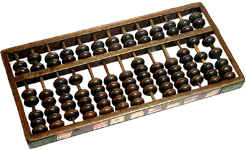Abacus: Calculate at the speed of thought
When can it be said that a skill has been mastered ? A skill is mastered when we are able to do something with utmost ease; instinctively, without any thought or effort. So whether it is a simple activity like riding a bicycle or a more complex one like playing a musical instrument, we practice a skill over and over again until it becomes automatic. When that happens, our mind becomes free to tackle the more complex aspects of the skill and becomes creative.
Since basic arithmetic is such an integral part of a child’s curriculum, is there a way for her to learn how to add, subtract, multiply and divide in such a manner that it becomes automatic? Yes, there are several ways and devices that enable a child to do this. But one of the most effective is the abacus.
Abacus is a counting device with a long history. It is essentially a frame mounted with rods along which beads can be moved. There are many versions of the device but the abacus as we know it today was invented in China around 1200 A.D. The Chinese abacus, called suan pan has 2 beads above a middle divider called a beam and 5 beads below.

Diagram of Suan Pan

Diagram of Soroban
The Japanese developed their own version of the abacus and they called it a soroban. A soroban has 14 rods and each rod has 1 bead above the beam and 4 below. The beads above the beam are called ‘the heaven beads’ and beads below ‘the earth beads’. Today, this is the version that is most popular across the world.
An abacus does not do any computing the way a calculator does. Essentially, it keeps a track of numbers as we calculate. Beads are moved back and forth on the rods and the position of a bead gives us its value. This way a small number of beads can depict large numbers which can, with practice, be read out instantly.
Abacus training is a process of discovery
When a child starts using an abacus, she makes several discoveries.
i) The first is the discovery that the device she thought was a toy is, in fact, an instrument that can add, subtract,
multiply and divide large numbers.
ii) Then the child realizes that there are other ways to read numbers, for example through beads and finger digits.
iii) An abacus helps a child to realize that apart from base 10, other bases can also be used to calculate. For instance, a
computer uses the base 2 and carries out all its operations by the numbers 0 and 1.
iV) But from the point of view of the child, the most important discovery is that an abacus is an activity that involves
sight, hearing and use of hands. This makes it fun.
V) After a while, the child makes yet another amazing discovery; that an abacus can be dispensed with altogether. It is
possible to visualize and manipulate the beads to calculate mentally.






